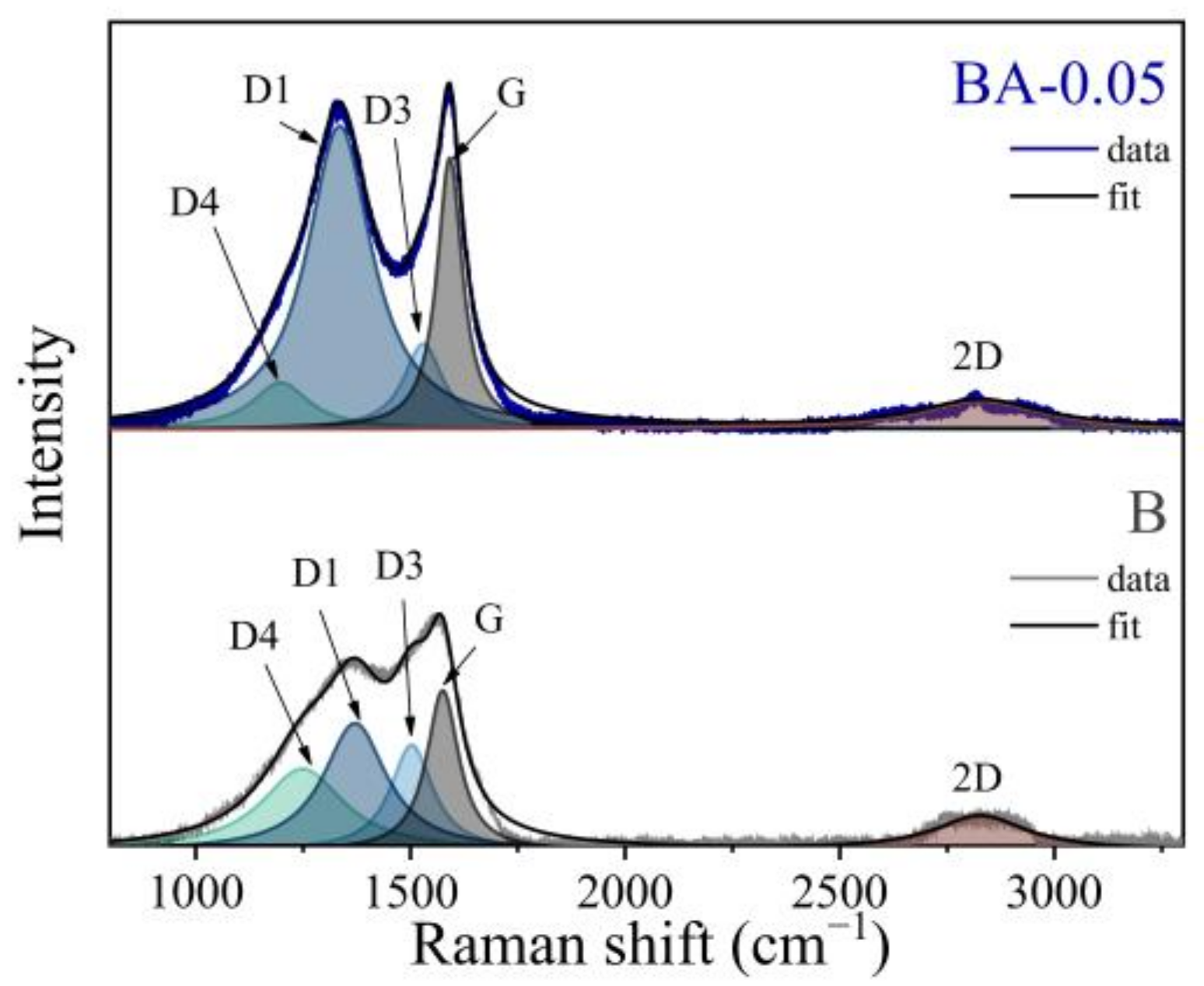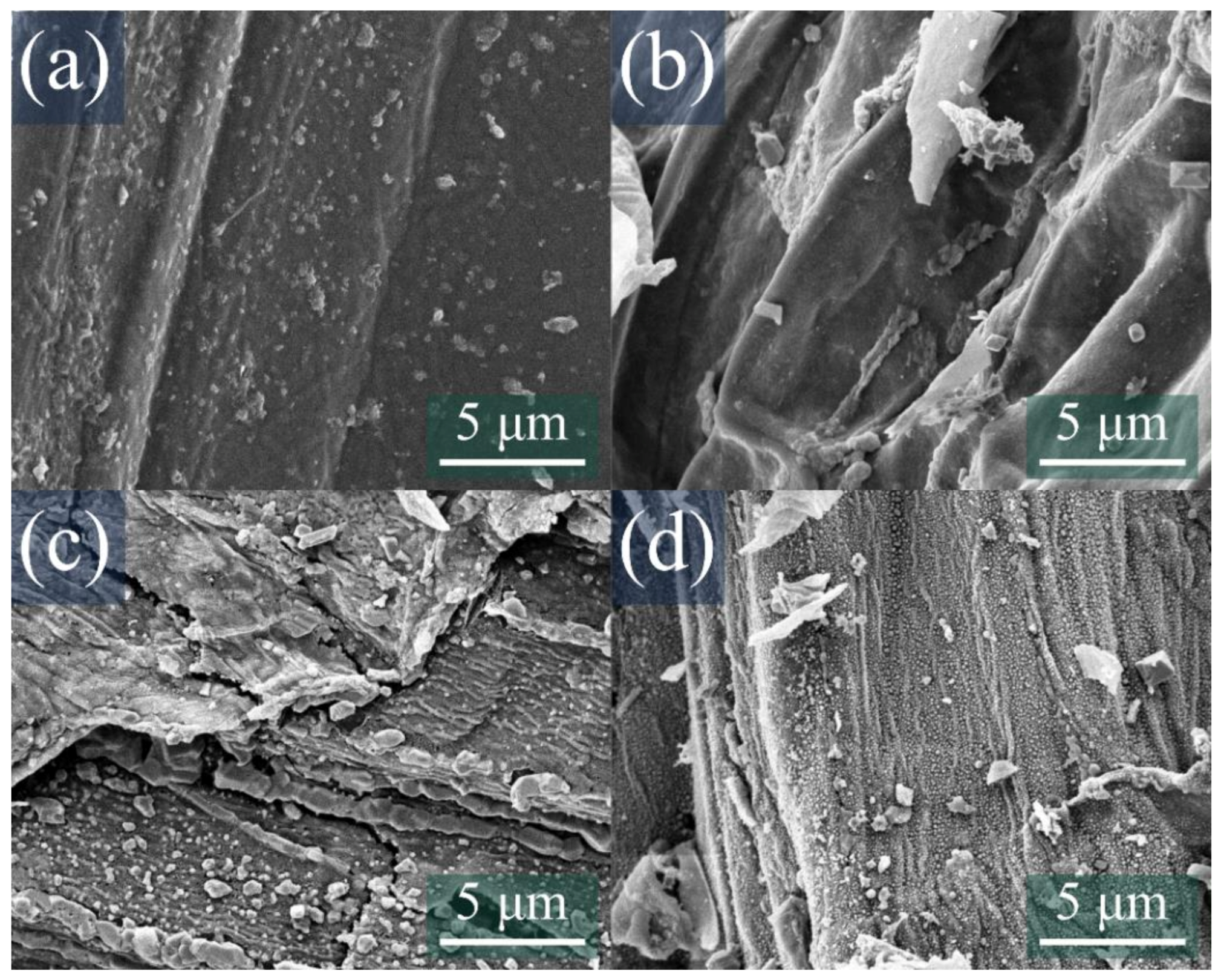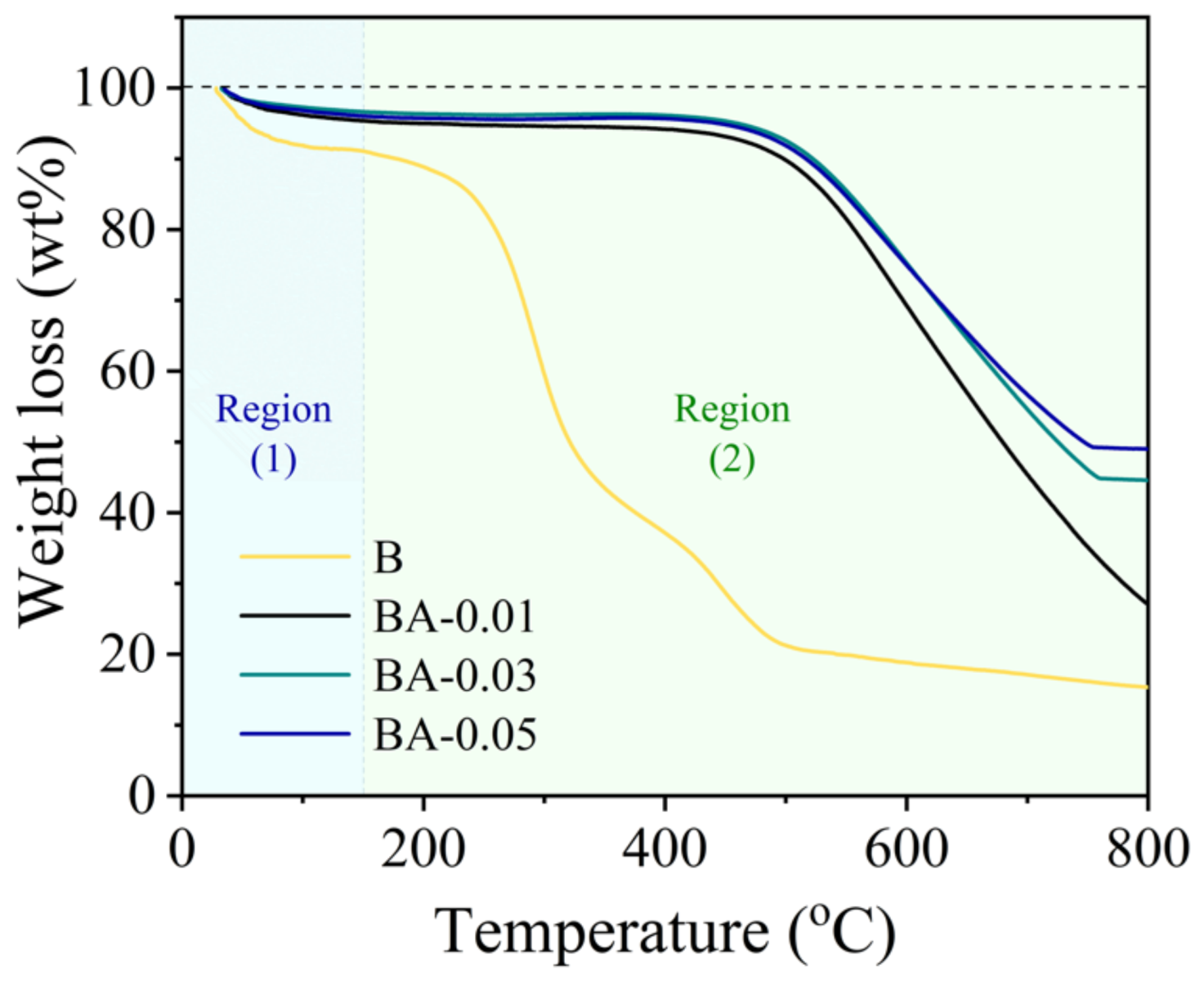Low-Cost Production of Fe3O4/C Nanocomposite Anodes Derived from Banana Stem Waste Recycling for Sustainable Lithium-Ion Batteries
Abstract
:1. Introduction
2. Materials and Methods
2.1. Nanocomposite Materials Preparation of Banana Stem Waste
2.2. Materials Characterization
2.3. Electrochemical Measurements
3. Results and Discussion
3.1. Physical Characterization
3.2. Electrochemical Characterization
4. Conclusions
Supplementary Materials
Author Contributions
Funding
Institutional Review Board Statement
Informed Consent Statement
Data Availability Statement
Acknowledgments
Conflicts of Interest
References
- Zubi, G.; Dufo-López, R.; Carvalho, M.; Pasaoglu, G. The Lithium-Ion Battery: State of the Art and Future Perspectives. Renew. Sustain. Energy Rev. 2018, 89, 292–308. [Google Scholar] [CrossRef]
- Mekonnen, Y.; Sundararajan, A.; Sarwat, A.I. A Review of Cathode and Anode Materials for Lithium-Ion Batteries. In Proceedings of the IEEE SoutheastCon 2016, Norfolk, VA, USA, 30 March–3 April 2016; pp. 1–6. [Google Scholar]
- Asenbauer, J.; Eisenmann, T.; Kuenzel, M.; Kazzazi, A.; Chen, Z.; Bresser, D. The Success Story of Graphite as a Lithium-Ion Anode Material-Fundamentals, Remaining Challenges, and Recent Developments Including Silicon (Oxide) Composites. Sustain. Energy Fuels 2020, 4, 5387–5416. [Google Scholar] [CrossRef]
- Yu, H.-Y.; Liang, H.-J.; Gu, Z.-Y.; Meng, Y.-F.; Yang, M.; Yu, M.-X.; Zhao, C.-D.; Wu, X.-L. Waste-to-Wealth: Low-Cost Hard Carbon Anode Derived from Unburned Charcoal with High Capacity and Long Cycle Life for Sodium-Ion/Lithium-Ion Batteries. Electrochim. Acta 2020, 361, 137041. [Google Scholar] [CrossRef]
- Thompson, E.; Danks, A.E.; Bourgeois, L.; Schnepp, Z. Iron-Catalyzed Graphitization of Biomass. Green Chem. 2015, 17, 551–556. [Google Scholar] [CrossRef]
- Wang, L.; Guo, Q.; Wang, J.; Li, H.; Wang, G.; Yang, J.; Song, Y.; Qin, Y.; Liu, L. Improved Cycling Performance of a Silicon Anode for Lithium Ion Batteries Using Carbon Nanocoils. RSC Adv. 2014, 4, 40812–40815. [Google Scholar] [CrossRef]
- Autthawong, T.; Chayasombat, B.; Laokawee, V.; Jarulertwathana, N.; Masuda, T.; Sarakonsri, T. Nanostructural Study of Silicon-Cobalt/Nitrogen-Doped Reduced Graphene Oxide Composites by Electron Microscopy for Using as Anode Material in Lithium-Ion Batteries. In Solid State Phenomena; Trans Tech Publications Ltd: Wollerau, Switzerland, 2018; Volume 283, pp. 37–45. [Google Scholar]
- Liu, L.; Xie, F.; Lyu, J.; Zhao, T.; Li, T.; Choi, B.G. Tin-Based Anode Materials with Well-Designed Architectures for next-Generation Lithium-Ion Batteries. J. Power Sources 2016, 321, 11–35. [Google Scholar] [CrossRef]
- Liu, X.; Wu, X.Y.; Chang, B.; Wang, K.X. Recent Progress on Germanium-Based Anodes for Lithium Ion Batteries: Efficient Lithiation Strategies and Mechanisms. Energy Storage Mater. 2020, 30, 146–169. [Google Scholar] [CrossRef]
- Autthawong, T.; Promanan, T.; Chayasombat, B.; Yu, A.S.; Uosaki, K.; Yamaguchi, A.; Kurata, H.; Chairuangsri, T.; Sarakonsri, T. Facile Synthesis Sandwich-Structured Ge/Nrgo Nanocomposite as Anodes for High-Performance Lithium-Ion Batteries. Crystals 2021, 11, 1582. [Google Scholar] [CrossRef]
- Lu, Y.; Yu, L.; Lou, X.W.D. Nanostructured Conversion-Type Anode Materials for Advanced Lithium-Ion Batteries. Chem 2018, 4, 972–996. [Google Scholar] [CrossRef]
- Liu, Z.; Andreev, Y.G.; Armstrong, A.R.; Brutti, S.; Ren, Y.; Bruce, P.G. Nanostructured TiO2(B): The Effect of Size and Shape on Anode Properties for Li-Ion Batteries. Prog. Nat. Sci. Mater. Int. 2013, 23, 235–244. [Google Scholar] [CrossRef]
- Deng, D.; Kim, M.G.; Lee, J.Y.; Cho, J. Green Energy Storage Materials: Nanostructured TiO2 and Sn-Based Anodes for Lithium-Ion Batteries. Energy Env. Sci. 2009, 2, 818–837. [Google Scholar] [CrossRef]
- Autthawong, T.; Yodbunork, C.; Yodying, W.; Boonprachai, R.; Namsar, O.; Yu, A.S.; Chimupala, Y.; Sarakonsri, T. Fast-Charging Anode Materials and Novel Nanocomposite Design of Rice Husk-Derived SiO2 and Sn Nanoparticles Self-Assembled on TiO2(B) Nanorods for Lithium-Ion Storage Applications. ACS Omega 2022, 7, 1357–1367. [Google Scholar] [CrossRef] [PubMed]
- Ratsameetammajak, N.; Autthawong, T.; Chairuangsri, T.; Kurata, H.; Yu, A.S.; Sarakonsri, T. Rice Husk-Derived Nano-SiO2 Assembled on Reduced Graphene Oxide Distributed on Conductive Flexible Polyaniline Frameworks towards High-Performance Lithium-Ion Batteries. RSC Adv. 2022, 12, 14621–14630. [Google Scholar] [CrossRef] [PubMed]
- Gomez-Martin, A.; Martinez-Fernandez, J.; Ruttert, M.; Heckmann, A.; Winter, M.; Placke, T.; Ramirez-Rico, J. Iron-Catalyzed Graphitic Carbon Materials from Biomass Resources as Anodes for Lithium-Ion Batteries. ChemSusChem 2018, 11, 2776–2787. [Google Scholar] [CrossRef]
- Qi, W.; Shapter, J.G.; Wu, Q.; Yin, T.; Gao, G.; Cui, D. Nanostructured Anode Materials for Lithium-Ion Batteries: Principle, Recent Progress and Future Perspectives. J. Mater. Chem. A Mater. 2017, 5, 19521–19540. [Google Scholar] [CrossRef]
- Boonprachai, R.; Autthawong, T.; Namsar, O.; Yodbunork, C.; Yodying, W.; Sarakonsri, T. Natural Porous Carbon Derived from Popped Rice as Anode Materials for Lithium-Ion Batteries. Crystals 2022, 12, 223. [Google Scholar] [CrossRef]
- He, C.; Wu, S.; Zhao, N.; Shi, C.; Liu, E.; Li, J. Carbon-Encapsulated Fe3O4 Nanoparticles as a High-Rate Lithium Ion Battery Anode Material. ACS Nano 2013, 7, 4459–4469. [Google Scholar] [CrossRef]
- Li, T.; Bai, X.; Qi, Y.X.; Lun, N.; Bai, Y.J. Fe3O4 Nanoparticles Decorated on the Biochar Derived from Pomelo Pericarp as Excellent Anode Materials for Li-Ion Batteries. Electrochim. Acta 2016, 222, 1562–1568. [Google Scholar] [CrossRef]
- Gong, J.; Li, J.; Xu, J.; Xiang, Z.; Mo, L. Research on Cellulose Nanocrystals Produced from Cellulose Sources with Various Polymorphs. RSC Adv. 2017, 7, 33486–33493. [Google Scholar] [CrossRef]
- Dresselhaus, M.S.; Jorio, A.; Saito, R. Characterizing Graphene, Graphite, and Carbon Nanotubes by Raman Spectroscopy. Annu. Rev. Condens. Matter Phys. 2010, 1, 89–108. [Google Scholar] [CrossRef]
- Charon, E.; Rouzaud, J.N.; Aléon, J. Graphitization at low temperatures (600–1200 °C) in the presence of iron implications in planetology. Carbon 2014, 66, 178–190. [Google Scholar] [CrossRef]
- Yin, Y.; Yin, J.; Zhang, W.; Tian, H.; Hu, Z.; Ruan, M.; Song, Z.; Liu, L. Effect of Char Structure Evolution During Pyrolysis on Combustion Characteristics and Kinetics of Waste Biomass. J. Energy Resour. Technol. 2018, 140, 1–10. [Google Scholar] [CrossRef]
- Gómez-Urbano, J.L.; Moreno-Fernández, G.; Arnaiz, M.; Ajuria, J.; Rojo, T.; Carriazo, D. Graphene-coffee waste derived carbon composites as electrodes for optimized lithium ion capacitors. Carbon 2020, 162, 273–282. [Google Scholar] [CrossRef]
- Subramanya, R.; Satyanarayana, K.G.; Shetty Pilar, B. Evaluation of Structural, Tensile and Thermal Properties of Banana Fibers. J. Nat. Fibers 2017, 14, 485–497. [Google Scholar]
- Zhao, X.; Xia, D.; Yue, J.; Liu, S. In-situ generated nano-Fe3C embedded into nitrogen-doped carbon for high performance anode in lithium ion battery. Electrochim. Acta 2014, 116, 292–299. [Google Scholar] [CrossRef]
- Huang, Y.-G.; Lin, X.-L.; Zhang, X.-H.; Pan, Q.-C.; Yan, Z.-X.; Wang, H.-Q.; Chen, J.-J.; Li, Q.-Y. Fe3C@carbon nanocapsules/expanded graphite as anode materials for lithium ion batteries. Electrochim. Acta 2015, 178, 468–475. [Google Scholar] [CrossRef]
- Luo, G.; Strong, P.J.; Wang, H.; Ni, W.; Shi, W. Kinetics of the Pyrolytic and Hydrothermal Decomposition of Water Hyacinth. Bioresour. Technol. 2011, 102, 6990–6994. [Google Scholar] [CrossRef] [PubMed]
- Gu, S.; Liu, Y.; Zhang, G.; Shi, W.; Liu, Y.; Zhu, J. Fe3O4/Carbon Composites Obtained by Electrospinning as an Anode Material with High Rate Capability for Lithium Ion Batteries. RSC Adv. 2014, 4, 41179–41184. [Google Scholar] [CrossRef]
- Ding, C.; Zeng, Y.; Cao, L.; Zhao, L.; Zhang, Y. Hierarchically Porous Fe3O4/C Nanocomposite Microspheres via a CO2 Bubble-Templated Hydrothermal Approach as High-Rate and High-Capacity Anode Materials for Lithium-Ion Batteries. J. Mater. Chem. A Mater. 2016, 4, 5898–5908. [Google Scholar] [CrossRef]
- Valvo, M.; Floraki, C.; Paillard, E.; Edström, K.; Vernardou, D. Perspectives on Iron Oxide-Based Materials with Carbon as Anodes for Li- and K-Ion Batteries. Nanomaterials 2022, 12, 1436. [Google Scholar] [CrossRef]
- Persson, K.; Sethuraman, V.A.; Hardwick, L.J.; Hinuma, Y.; Meng, Y.S.; van der Ven, A.; Srinivasan, V.; Kostecki, R.; Ceder, G. Lithium Diffusion in Graphitic Carbon. J. Phys. Chem. Lett. 2010, 1, 1176–1180. [Google Scholar] [CrossRef]
- Kim, M.S.; Bhattacharjya, D.; Fang, B.; Yang, D.S.; Bae, T.S.; Yu, J.S. Morphology-Dependent Li Storage Performance of Ordered Mesoporous Carbon as Anode Material. Langmuir 2013, 29, 6754–6761. [Google Scholar] [CrossRef]
- Thapaliya, B.P.; Luo, H.; Halstenberg, P.; Meyer, H.M.; Dunlap, J.R.; Dai, S. Low-Cost Transformation of Biomass-Derived Carbon to High-Performing Nano-Graphite via Low-Temperature Electrochemical Graphitization. ACS Appl. Mater. Interfaces 2021, 13, 4393–4401. [Google Scholar] [CrossRef]
- Bredar, A.R.C.; Chown, A.L.; Burton, A.R.; Farnum, B.H. Electrochemical Impedance Spectroscopy of Metal Oxide Electrodes for Energy Applications. ACS Appl. Energy Mater. 2020, 3, 66–98. [Google Scholar] [CrossRef]
- Wang, Q.; Mao, B.; Stoliarov, S.I.; Sun, J. A Review of Lithium Ion Battery Failure Mechanisms and Fire Prevention Strategies. Prog. Energy Combust. Sci. 2019, 73, 95–131. [Google Scholar] [CrossRef]
- Long, W.; Fang, B.; Ignaszak, A.; Wu, Z.; Wang, Y.J.; Wilkinson, D. Biomass-Derived Nanostructured Carbons and Their Composites as Anode Materials for Lithium Ion Batteries. Chem. Soc. Rev. 2017, 46, 7176–7190. [Google Scholar] [CrossRef]
- Ma, S.; Jiang, M.; Tao, P.; Song, C.; Wu, J.; Wang, J.; Deng, T.; Shang, W. Temperature effect and thermal impact in lithium-ion batteries: A review. Prog. Nat.Sci. Mater. Int. 2018, 28, 653–666. [Google Scholar] [CrossRef]
- Yi, X.; He, W.; Zhang, X.; Yue, Y.; Yang, G.; Wang, Z.; Zhou, M.; Wang, L. Graphene-like carbon sheet/Fe3O4 nanocomposites derived from soda papermaking black liquor for high performance lithium ion batteries. Electrochim. Acta 2017, 232, 550–560. [Google Scholar] [CrossRef]
- Huang, Y.; Li, X.; Xu, X.; Wei, F.; Wang, Y.; Ma, M.; Wang, Y.; Sun, D. Green and up-scalable fabrication of superior anodes for lithium storage based on biomass bacterial cellulose. Adv. Powder Technol. 2021, 32, 2484–2492. [Google Scholar] [CrossRef]
- Li, R.; Kamali, A.R. Clean preparation of Fe2SiO4 coated Fe2O3 integrated with graphene for Li-ion storage application. Colloids Surf. A Physicochem. Eng. Asp. 2023, 656, 130275. [Google Scholar] [CrossRef]
- Gomez-Martin, A.; Martinez-Fernandez, J.; Ruttert, M.; Winter, M.; Placke, T.; Ramirez-Rico, J. Porous Graphene-like Carbon from Fast Catalytic Decomposition of Biomass for Energy Storage Applications. ACS Omega 2019, 4, 21446–21458. [Google Scholar] [CrossRef] [PubMed]
- Liu, Y.; Li, X.; Haridas, A.K.; Sun, Y.; Heo, J.; Ahn, J.H.; Lee, Y. Biomass-Derived Graphitic Carbon Encapsulated Fe/Fe3C Composite as an Anode Material for High-Performance Lithium Ion Batteries. Energies 2020, 13, 827. [Google Scholar] [CrossRef]
- Li, B.; Zhang, Y.; Xiong, J.; Gui, Y.; Huang, T.; Peng, J.; Liu, H.; Yang, F.; Li, M. Chitosan-derived graphitic carbon@Fe3C as anode materials for lithium ion battery. J. Mater. Sci. 2022, 9939–9954. [Google Scholar] [CrossRef]
- Zhu, T.; Chen, J.S.; Lou, X.W. Glucose-Assisted One-Pot Synthesis of FeOOH Nanorods and Their Transformation to Fe3O4@carbon Nanorods for Application in Lithium Ion Batteries. J. Phys. Chem. C 2011, 115, 9814–9820. [Google Scholar] [CrossRef]
- Zhang, W.M.; Wu, X.L.; Hu, J.S.; Guo, Y.G.; Wan, L.J. Carbon Coated Fe3O4 Nanospindles as a Superior Anode Material for Lithium-Ion Batteries. Adv. Funct. Mater. 2008, 18, 3941–3946. [Google Scholar] [CrossRef]
- Lin, P.C.; Wu, J.Y.; Liu, W.R. Green and Facile Synthesis of Few-Layer Graphene via Liquid Exfoliation Process for Lithium-Ion Batteries. Sci. Rep. 2018, 8, 9766. [Google Scholar] [CrossRef]
- Choi, W.; Shin, H.C.; Kim, J.M.; Choi, J.Y.; Yoon, W.S. Modeling and Applications of Electrochemical Impedance Spectroscopy (Eis) for Lithium-Ion Batteries. J. Electrochem. Sci. Technol. 2020, 11, 1–13. [Google Scholar] [CrossRef]
- Autthawong, T.; Yodbunork, C.; Ratsameetammajak, N.; Namsar, O.; Chimupala, Y.; Sarakonsri, T. Enhanced Electrochemical Performance of Sn(SnO2)/TiO2(B) Nanocomposite Anode Materials with Ultrafast Charging and Stable Cycling for High-Performance Lithium-Ion Batteries. ACS Appl. Energy Mater. 2022, 5, 13829–13842. [Google Scholar] [CrossRef]
- Lin, Q.; Wang, J.; Zhong, Y.; Sunarso, J.; Tadé, M.O.; Li, L.; Shao, Z. High Performance Porous Iron Oxide-Carbon Nanotube Nanocomposite as an Anode Material for Lithium-Ion Batteries. Electrochim. Acta 2016, 212, 179–186. [Google Scholar] [CrossRef]
- Duan, W.; Zhu, Z.; Li, H.; Hu, Z.; Zhang, K.; Cheng, F.; Chen, J. Na3V2(PO4)3@C Core-Shell Nanocomposites for Rechargeable Sodium-Ion Batteries. J. Mater. Chem. A Mater. 2014, 2, 8668–8675. [Google Scholar] [CrossRef]








| TGA Data Analysis Results | Synthesized Products | |||
|---|---|---|---|---|
| B | BA-0.01 | BA-0.03 | BA-0.05 | |
| Dehydration (water, wt%) | 8.93 | 4.62 | 3.37 | 3.95 |
| Initial weight at 150 °C (wt%) | 91.07 | 95.38 | 96.63 | 96.05 |
| Region (1), RT-150 °C (wt% loss) | 8.93 | 4.62 | 3.37 | 3.95 |
| Region (2), 150–800 °C (wt% loss) | 75.72 | 68.34 | 52.05 | 46.95 |
| Solid weight after 800 °C (Fe2O3, wt%) | 15.35 * | 27.04 | 44.58 | 49.10 |
| Fe3O4 (calculated weight, wt%) | - | 26.73 | 44.44 | 49.26 |
| Carbon (calculated weight, wt%) | 83.14 | 73.27 | 55.56 | 50.74 |
| Theoretical specific capacity (mAh/g) | - | 520 | 617 | 644 |
| Electrode | Interpretation and Calculation of Nyquist Plots | |||
|---|---|---|---|---|
| Rs (Ω) | RSEI (Ω) | Rct (Ω) | σw (Ω/s1/2) | |
| BA-0.05 (pre-cycle) | 4.08 | - | 12.90 | 1.74 |
| BA-0.05 (post-cycle) | 8.27 | 5.97 | 17.60 | 1.94 |
Disclaimer/Publisher’s Note: The statements, opinions and data contained in all publications are solely those of the individual author(s) and contributor(s) and not of MDPI and/or the editor(s). MDPI and/or the editor(s) disclaim responsibility for any injury to people or property resulting from any ideas, methods, instructions or products referred to in the content. |
© 2023 by the authors. Licensee MDPI, Basel, Switzerland. This article is an open access article distributed under the terms and conditions of the Creative Commons Attribution (CC BY) license (https://creativecommons.org/licenses/by/4.0/).
Share and Cite
Yodying, W.; Sarakonsri, T.; Ratsameetammajak, N.; Khunpakdee, K.; Haruta, M.; Autthawong, T. Low-Cost Production of Fe3O4/C Nanocomposite Anodes Derived from Banana Stem Waste Recycling for Sustainable Lithium-Ion Batteries. Crystals 2023, 13, 280. https://doi.org/10.3390/cryst13020280
Yodying W, Sarakonsri T, Ratsameetammajak N, Khunpakdee K, Haruta M, Autthawong T. Low-Cost Production of Fe3O4/C Nanocomposite Anodes Derived from Banana Stem Waste Recycling for Sustainable Lithium-Ion Batteries. Crystals. 2023; 13(2):280. https://doi.org/10.3390/cryst13020280
Chicago/Turabian StyleYodying, Waewwow, Thapanee Sarakonsri, Natthakan Ratsameetammajak, Kittiched Khunpakdee, Mitsutaka Haruta, and Thanapat Autthawong. 2023. "Low-Cost Production of Fe3O4/C Nanocomposite Anodes Derived from Banana Stem Waste Recycling for Sustainable Lithium-Ion Batteries" Crystals 13, no. 2: 280. https://doi.org/10.3390/cryst13020280







